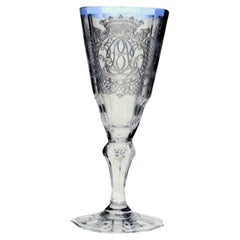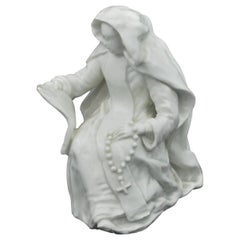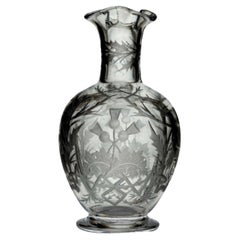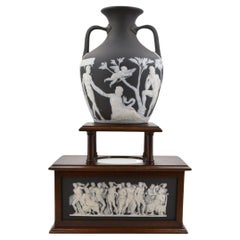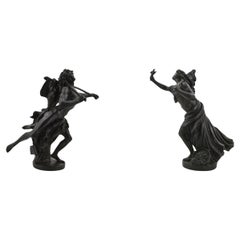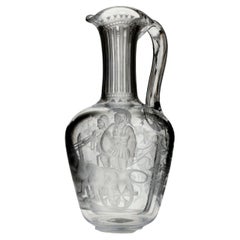Etruria Antiques Gallery Furniture
to
103
280
141
20
12
12
2
2
1
1
1
201
53
26
18
5
3
7
5
1
1
260
155
70
25
15
273
264
237
11
4
280
280
280
76
72
21
10
3
Engraved Warmbrunn wine glass with gilt rim. Silesia C1720.
Located in Melbourne, Victoria
A gorgeous conical wine glass with elaborate engraving encompassing a monogram below a crown, and a gilt rim.
Warmbrunn glass, also known as Warmbrunner glass, refers to a type of ...
Category
Antique Early 18th Century German Neoclassical Crystal Serveware
Materials
Blown Glass
A Nun, perhaps a theatrical figure. England, probably Plymouth, circa 1750
By Plymouth Porcelain Factory 1
Located in Melbourne, Victoria
An interesting soft-paste porcelain figure of a Dominican Nun, perhaps the theatrical figure Heloise.
Although the Nun appears in various versions in European and English porcelain,...
Category
Antique Late 18th Century English Neoclassical Porcelain
Materials
Porcelain
Wheel-Cut glass whisky carafe, Stourbridge, C1860
By Thomas Webb & Sons
Located in Melbourne, Victoria
A carafe of pleasing shape & proportions, with elaborate wheel-cut decoration of thistles and thorns. Possibly intended for whisky - or at least the water to be added to it; but it c...
Category
Antique Mid-19th Century British Neoclassical Revival Crystal Serveware
Materials
Blown Glass
Portland Vase. Barnard Edition (Bert Bentley). Wedgwood C1925
By Wedgwood
Located in Melbourne, Victoria
In the early 1920s, Wedgwood decided to produce an exceptional edition of the Portland Vase, and Harry Barnard embarked on 3-4 years of experiments, which resulted in this superb and...
Category
Early 20th Century English Neoclassical Revival Pottery
Materials
Pottery
Pair of Bacchantes in Black Basalt. Wedgwood C1860.
By Wedgwood
Located in Melbourne, Victoria
Perhaps the most complex work in black basalt undertaken on any scale by Wedgwood, the Bacchantes, are adapted from sculptures by Clodion. A large and impressive pair, ful of vigour ...
Category
Antique Mid-19th Century English Neoclassical Pottery
Materials
Stoneware
$13,500 / set
Wheel-Cut glass Claret Jug, Stourbridge, C1850
By Thomas Webb & Sons
Located in Melbourne, Victoria
The height of English glass cutting, and a perfect example of the Victorian early neo-classical revival.
Decorated with two Roman solidiers in a chariot drawn by two horses to the f...
Category
Antique Mid-19th Century British Neoclassical Revival Crystal Serveware
Materials
Blown Glass
Basalt Portrait Medallion, Edward Bourne, Wedgwood, circa 1780
By Wedgwood
Located in Melbourne, Victoria
Portrait Medallion of Edward Bourne, bricklayer at the Wedgwood factory. A bricklayer was kept on staff in order to maintain the kilns.
This was modelled by Hackwood as an excercise...
Category
Antique Late 18th Century English Neoclassical Figurative Sculptures
Materials
Stoneware
Encaustic Painted Basalt Vase, Wedgwood, circa 1780
By Wedgwood
Located in Melbourne, Victoria
A fine, large vase in black basalt, decorated with an encaustic painted figure of a youth and an older man, taken from The Hamilton vase in the British Museum. It is unusual to find ...
Category
Antique Late 18th Century English Neoclassical Pottery
Materials
Stoneware
Whieldonware Teapot, England, C1765
Located in Melbourne, Victoria
A charming, tiny, one-cup teapot in creamware with crabstock handle and spout, and ‘Whieldonware’ decoration. Teapots of this size date from the time each person was given his own po...
Category
Antique Mid-18th Century English Chinoiserie Pottery
Materials
Earthenware
$2,320 Sale Price
20% Off
Oval Teapot in Black Basalt, Turner, circa 1790
By John Turner
Located in Melbourne, Victoria
An excellent black basalt teapot, with engine turned decoration and widow finial. Most unusually, this example is marked.
Category
Antique Late 18th Century English Neoclassical Pottery
Materials
Stoneware
Earl's Coronet, in Silver-Gilt with Ermine and Velvet, Hunt & Roskell, 1911
Located in Melbourne, Victoria
An Earl’s Coronet, in silver-gilt, by Hunt & Roskell: the firm formerly known as Storr & Mortimer, a direct line to Paul Storr. Made in 1911, no doubt for...
Category
Early 20th Century British Neoclassical Sterling Silver
Materials
Sterling Silver
$10,000 Sale Price
20% Off
Sauce Boat, Fringed Tree Pattern, Worcester, circa 1755
By 1st Period Worcester Dr. Wall
Located in Melbourne, Victoria
An unusual shape with an uncommon painted pattern: Fringed Tree. The combination is scarce.
Workman’s mark.
In the 18th century, sauce boats were a common serving vessel used ...
Category
Antique Mid-18th Century English Chinoiserie Porcelain
Materials
Porcelain
Salt Glaze Sauce Boat, Barley-Corn Pattern, English, circa 1755
Located in Melbourne, Victoria
An excellent example of the popular Barleycorn pattern, crisply moulded in panels to the sides, with graceful sprigs. Salt-glaze particularly suits this sort of fine relief.
Excel...
Category
Antique Mid-18th Century English Neoclassical Pottery
Materials
Stoneware
Majolica Sweetmeat Stand, Wedgwood, circa 1865
By Minton
Located in Melbourne, Victoria
A brightly coloured majolica sweetmeat dish in the form of a bucolic young man leaning on a basket.
Minton majolica is a type of ceramic ware that was produced by the Minton pottery in the 19th century. It was created in response to the growing popularity of Italian Renaissance maiolica...
Category
Antique Mid-18th Century English Rococo Pottery
Materials
Majolica
$750 Sale Price
25% Off
Small Teapot in Caneware with Spaniel Finial. Wedgwood, circa 1820
By Wedgwood
Located in Melbourne, Victoria
An unglazed caneware teapot of depressed oval shape, with arabesque decoration and a spaniel finial.
Wedgwood caneware is a type of pottery that w...
Category
Antique 1820s English Neoclassical Pottery
Materials
Stoneware
$800 Sale Price
20% Off
Tea Bowl and Saucer, Pencilled with Boy on a Buffalo, Worcester, circa 1755
By 1st Period Worcester Dr. Wall
Located in Melbourne, Victoria
A very fine tea-bowl and saucer, with a pencilled decoration of the pattern Boy on a Buffalo, after the Chinese.
The porcelain is eggshell-thin, something Worcester did for only a...
Category
Antique Mid-18th Century English Chinoiserie Porcelain
Materials
Porcelain
Double-Handled Sauce Boat, Chantilly, circa 1770
Located in Melbourne, Victoria
A double-handled sauce boat, with simple cobalt decoration.
Category
Antique Late 18th Century French Neoclassical Porcelain
Materials
Porcelain
$2,400 Sale Price
20% Off
Butter Boat, Two Peony Rockbird Pattern, Worcester, circa 1755
By 1st Period Worcester Dr. Wall
Located in Melbourne, Victoria
A particularly successful dish, formed in the shape of a leaf, and decorated with underglaze blue painting after the Chinese.
The Two Peony Rockbird pattern is a traditional Chine...
Category
Antique Mid-18th Century English Chinoiserie Porcelain
Materials
Porcelain
Basalt Portrait Medallion, William of Orange, Wedgwood, circa 1785
By Wedgwood
Located in Melbourne, Victoria
A self-framing portrait medallion of William of Orange. The mixed-vase mark dates this example firmly in the 1780s. Wedgwood produced a number of co...
Category
Antique Late 18th Century English Neoclassical Figurative Sculptures
Materials
Stoneware
Mantle Clock in Black Jasper Dip, by Bert Bentley, Wedgwood, circa 1925
By Wedgwood
Located in Melbourne, Victoria
A fine mantle clock in black jasper dip, decorated by Bert Bentley with Sacrifice to the front. To one side, Polymnia; to the other, an unidentified female ...
Category
Early 20th Century English Neoclassical Revival Mantel Clocks
Materials
Stoneware
Australian Bicentenary Bowl, Wedgwood, circa 1988. Number 10 of 50 Made
By Wedgwood
Located in Melbourne, Victoria
In Royal Blue dip; a colour normally reserved for Coronation commemoratives. One of only fifty made; made to mark the bicentenary of the found...
Category
Vintage 1980s English Neoclassical Pottery
Materials
Stoneware
$900 Sale Price
25% Off
Claret Jug with Etched Decoration, Attribute to Richardsons, Stourbridge, c 1880
By Thomas Richardson
Located in Melbourne, Victoria
A 19th century Stourbridge claret jug, probably by Richardsons, of footed moon-flask form with slender neck, rope twist handle and hollow blown stopper, acid etched with cartouche panels of flowers and foliage.
Richardsons of Stourbridge was a glass manufacturer located in Stourbridge, England, that produced high-quality glassware from the Mid-19th Century to the early 20th century. The company was founded by Thomas Richardson...
Category
Antique Late 19th Century British Victorian Crystal Serveware
Materials
Blown Glass
Oval Dish, Chantilly, circa 1770
By Chantilly
Located in Melbourne, Victoria
Underplate from a tureen or similar; decorated with simple cobalt decoration.
The history of Chantilly porcelain can be traced back to around 17...
Category
Antique Late 18th Century French Neoclassical Porcelain
Materials
Porcelain
$1,200 Sale Price
20% Off
Tea Cup & Saucer, Saint Cloud, circa 1730
By Saint Cloud
Located in Melbourne, Victoria
Both cup and saucer with moulded reeding and decorated in underglaze blue with scrolled lambrequin borders.
Saint Cloud porcelain is a type of soft-paste porcelain produced in the French town of Saint Cloud from the late 17th century to the mid-18th century. It was one of the earliest European attempts to produce porcelain and is known for its delicate, pale blue-gray glaze and simple, elegant designs.
The history of Saint Cloud porcelain can be traced back to the late 17th century when a group of Flemish potters settled in the town of Saint Cloud, which was then a royal estate...
Category
Antique Early 18th Century French Neoclassical Porcelain
Materials
Porcelain
Figure of a Nun, Perhaps Heloise, Bow Porcelain Factory, circa 1750
By Bow Porcelain
Located in Melbourne, Victoria
A classic example of early bow porcelain.
The figure is of a Dominican Nun, and is based on a continental model, probably Meissen.
Bow produced a number of apparently religious...
Category
Antique Mid-18th Century English Neoclassical Porcelain
Materials
Porcelain
Engraved Decanter in the Form of a Bottle TG Hawkes & Co., circa 1930
By T. G. Hawkes & Co.
Located in Melbourne, Victoria
A decanter in the form of a bottle, with sterling silver top and entensive engraved decoration. The lock is a convincing sham, which looks secure but opens easily without a key.
The top is stamped Sterling, and the base has an etched mark for Hawkes.
T.G. Hawkes & Co. was a prominent American glass manufacturer that operated from the late 19th century to the early 20th century. The company was founded by Thomas G. Hawkes in 1880 in Corning, New York, which was already a center of glass manufacturing.
T.G. Hawkes & Co. specialized in the production of high-quality cut glass, also known as crystal glass, which was a popular luxury item during the late 19th and early 20th centuries. The company quickly established a reputation for producing some of the finest cut glass in the world, and its products were highly sought after by wealthy Americans and Europeans.
Hawkes' cut glass was known for its intricate designs, precise cuts, and brilliant shine. The company's designs ranged from simple geometric patterns to more intricate floral and scroll designs, and many pieces were also engraved with intricate scenes and motifs.
T.G. Hawkes & Co. was a major supplier of glassware to luxury retailers, such as Tiffany & Co. and Cartier, and its products were used in many prestigious events, such as White House state dinners...
Category
Vintage 1930s American Art Deco Crystal Serveware
Materials
Blown Glass
Pair of framed Roundels in Black Jasperware, Wedgwood, circa 1920
By Wedgwood
Located in Melbourne, Victoria
An exceptionally fine pair of roundels in black jasperware, decorated with two images of Cupid: The first sharpening his arrows; the second, of him st...
Category
Early 20th Century English Neoclassical Figurative Sculptures
Materials
Stoneware
Campana Vase in White & Gilt Victoriaware, Wedgwood circa 1880
By Wedgwood
Located in Melbourne, Victoria
A marvellous combination of Wedgwood's traditional neoclassical style, in the form of a campana vase; which has been decorated in High Victorian style with gilt and bronzing.
Category
Antique Late 19th Century English High Victorian Pottery
Materials
Stoneware
Portrait Medallions David Garrick & Sarah Siddons, Wedgwood, 19th Century
By Wedgwood
Located in Melbourne, Victoria
A matched pair of portrait medallions showing the famous actors Mr Garrick (C1830) and Mrs Siddons, (circa 1880). Framed as a pair, they work well together.
David Garrick and Sarah Siddons...
Category
Antique Mid-19th Century English Neoclassical Pottery
Materials
Pottery
$900 Sale Price / set
35% Off
Basalt Portrait Medallion, Oliver Cromwell, Wedgwood, circa 1775
By Wedgwood
Located in Melbourne, Victoria
A self-framing portrait medallion of Oliver Cromwell, MP: rebel, regicide, suppressor of Ireland, persecutor of Catholics, and Dictator. He was posthum...
Category
Antique Late 18th Century English Neoclassical Figurative Sculptures
Materials
Stoneware
$975 Sale Price
25% Off
Potpourri in Cobalt Jasperware, Wedgwood, circa 1820
By Wedgwood
Located in Melbourne, Victoria
A broad, flat potpourri in cobalt jasper dip, with a tall pierced cover.
Category
Antique Mid-19th Century English Neoclassical Pottery
Materials
Pottery
$910 Sale Price
35% Off
Large Bust of the Pieta, Ralph Wood Jr, circa 1790
By Ralph Wood Pottery
Located in Melbourne, Victoria
A large and impressive bust, taken from Michelangelo’s Pietà. Creamware, modelled and made by Ralph Wood, with enamelling.
Category
Antique Late 18th Century English Neoclassical Pottery
Materials
Earthenware
Tea Bowl & Saucer, Chelsea, circa 1752
By Chelsea Porcelain
Located in Melbourne, Victoria
An octagonal tea bowl and matching saucer, decorated with Chelsea's usual beautiful flower painting.
One of the most distinctive features of Chelsea porcelain is its intricate floral painting, which often featured detailed, lifelike renditions of flowers and other botanical subjects. The factory employed skilled artists who were trained in the art of flower painting, and the results have always been highly prized by collectors.
Chelsea porcelain is highly collectible and has a reputation for being of exceptional quality. It is often considered to be among the finest examples of English porcelain...
Category
Antique Mid-18th Century English Neoclassical Porcelain
Materials
Porcelain
$1,200 Sale Price
20% Off
Enormous Portrait Medallion of Dr Priestly, Bert Bentley, Wedgwood, circa 1925
By Wedgwood
Located in Melbourne, Victoria
Fabulously large and fine example of the work of the well-known decorator Bert Bentley. Very few portrait medallions of this size were made, in all the time that Wedgwood has been making portrait medallions.
Priestly's advocacy for free speech and freedom of religion...
Category
Early 20th Century English Neoclassical Revival Pottery
Materials
Stoneware
Hot Milk Jug, Engine-Turned Jasperware. Wedgwood, C1785
By Wedgwood
Located in Melbourne, Victoria
Superb and exceptionally rare small jug in tricolour engine-turned diceware.
This is very early jasperware, made when "cherokee clay" was still being used. This clay, sourced from America, contained kaolin, the ingredient that makes porcelain translucent.
Exhibited: Wedgwood, Master Potter to the Universe, Roche Foundation, 2023.
Engine turning, also known as guilloche, is a decorative technique that was commonly used on eighteenth-century pottery. The process involved cutting intricate, repetitive patterns into a metal or ceramic surface using a machine known as a rose engine...
Category
Antique Late 18th Century English Neoclassical Pottery
Materials
Stoneware
Pair of Pattern 1166 Vases, Spode, C1820
By Spode
Located in Melbourne, Victoria
Pair of vases in the ancient Greek shape known as Kanteros, decorated with pattern 1166. A stunning pair, in excellent condition. The flower painting on these vases is exceptional, even for the Regency period, when English flower painting was at its height.
The Kantharos shape is a type of ancient Greek vase that was used for drinking wine. It was named after the word "kantharos," which was used to describe a type of two-handled cup in ancient Greece. The Kantharos shape is characterized by a large bowl, small base, and two wide handles that rise up from the sides of the bowl and curve upwards towards the rim. The shape was used primarily for drinking wine at symposia, or social gatherings, and was also used in religious ceremonies.
Kantharos vases were produced in a variety of materials, including clay, bronze, and silver, and were decorated with a range of motifs, including mythical scenes, animal figures, and floral designs. They were often used to serve wine, but were also used to hold other liquids such as oil or water.
The Kantharos shape was widely used throughout the ancient world, and examples have been found in archaeological sites from Greece to Italy to Asia Minor. It is considered a classic example of ancient Greek pottery and is an important part of the history of Greek...
Category
Antique Early 19th Century English Regency Garniture
Materials
Porcelain
$14,400 Sale Price / set
20% Off
Jasperware Buckle, Wedgwood, Matthew Boulton, Circa 1795
By Wedgwood
Located in Melbourne, Victoria
A jasper medallion decorated with Aphrodite, set in cut steel as a buckle, probably by Matthew Boulton. Original box.
The Greek goddess Aphrodite is often depicted in ancient art with a dolphin. In mythology, dolphins were considered sacred to Aphrodite, and they were associated with love, beauty, and fertility. According to one legend, Aphrodite emerged from the sea on a shell-borne chariot drawn by dolphins, and the creatures were said to be her faithful servants. As a result, images of Aphrodite with dolphins became a popular motif in Greek art, appearing on vases, sculptures, and other decorative objects. The association between Aphrodite and dolphins has continued through the centuries, and the image of the goddess with a dolphin remains a popular symbol of love and beauty.
Matthew Boulton (1728-1809) was an English manufacturer and entrepreneur who was best known for his contributions to the Industrial Revolution...
Category
Antique Mid-19th Century English Neoclassical Pottery
Materials
Cut Steel
Pattern 1166 Campana Vase. Spode, C1820
By Spode
Located in Melbourne, Victoria
Classical meets regency: A miniature campana vase, decorated with pattern 1166. This pattern, despite its lasting popularity, has never been given a common name; perhaps because of t...
Category
Antique Early 19th Century English Regency Garniture
Materials
Porcelain
Teapot, Derby Porcelain Works, circa 1775
By Derby
Located in Melbourne, Victoria
A gadrooned, canon-ball shape teapot, decorated with typical sprays of natural flowers. The shape and decoration are both in imitation of Meissen.
The Derby Porcelain Works, now known as the Royal Crown Derby Porcelain Company, is a British manufacturer of fine bone china. The company has a long and rich history dating back to the late 18th century.
The company was founded in 1750 as the Derby China Works. It was originally located in the city of Derby and produced a wide range of ceramic wares, including tea sets, vases, and figurines. In 1756, the company was granted the status of "Supplier to the King," which allowed it to use the "Royal" designation in its name.
In the late 18th and early 19th centuries, the company experienced significant growth and expanded its product line to include more elaborate and ornate pieces. The company was particularly known for its "Derby Posies...
Category
Antique Late 18th Century English Neoclassical Porcelain
Materials
Porcelain
$960 Sale Price
20% Off
Trophy Plate, Wedgwood, circa 1880
By Wedgwood
Located in Melbourne, Victoria
Trophy plates were a particularly Victorian development at Wedgwood, taking the use of classical ornament to its absolute limit. Over 2,000 individual sprigs were made, applied, and ...
Category
Antique Late 19th Century English Neoclassical Revival Pottery
Materials
Stoneware
Encaustic Painted Cup & Saucer, Wedgwood, circa 1820
By Wedgwood
Located in Melbourne, Victoria
A particularly fine example of a cup and saucer in the neoclassical style, simply decorated with a red line and a '"Leaf & Berry" motif.
The "leaf and berry" motif is a design element that is often found in neoclassical architecture and decorative arts. It features stylized leaves and berries arranged in a symmetrical pattern. This motif is commonly found on friezes, cornices, and other architectural elements, as well as on furniture, ceramics, and other decorative objects. It is associated with the neoclassical period, which began in the late 18th century and was characterized by a renewed interest in the classical art and architecture of ancient Greece and Rome...
Category
Antique Early 19th Century English Neoclassical Pottery
Materials
Stoneware
$960 Sale Price
20% Off
Encaustic Painted Basalt Vase, Wedgwood, circa 1800
By Wedgwood
Located in Melbourne, Victoria
A fine, large vase in black basalt, decorated with an encaustic painted figure of a youth, taken from The Hamilton vase in the British Museum.
The shape is taken from the Greek Hydria...
Category
Antique Late 18th Century English Neoclassical Pottery
Materials
Stoneware
Punch Powl, Bow Porcelain Factory, circa 1755
By Bow Porcelain
Located in Melbourne, Victoria
A rather splendid punch bowl from the Bow Porcelain Factory, enameled with flowers and insects in the Famille Rose style. A good size, at almost nine inches in diameter.
Famille R...
Category
Antique Mid-18th Century English Chinoiserie Porcelain
Materials
Porcelain
$1,360 Sale Price
20% Off
Big Framed Jasper Medallion, Clio by Bert Bentley, Wedgwood, circa 1925
By Wedgwood
Located in Melbourne, Victoria
Unusually large and fine example of the work of the well-known decorator Bert Bentley. Clio, the muse of History, is reproduced with the exceptional quality that has made his work so desirable.
Clio is the Greek muse...
Category
Early 20th Century English Neoclassical Revival Pottery
Materials
Stoneware
Bust of Sir Isaac Newton, Pearlware, Ralph & Enoch Wood, circa 1790
By Ralph Wood Pottery
Located in Melbourne, Victoria
A pearlware bust of Sir Isaac Newton, by Enoch Wood. The oak pedestal adds dignity to an attractive rendering of this great man of science. A handwrit...
Category
Antique Late 18th Century English Neoclassical Pottery
Materials
Pearlware
Flame Fairyland Lustre Vase: Tree Serpent
By Wedgwood, Daisy Makeig-Jones
Located in Melbourne, Victoria
A tall, well-proportioned vase in Flame Fairyland Lustre, decorated with Tree Serpent pattern and Imps on a Bridge (pattern Z5360).
Exhibited: Wedgwood, Master Potter to the Univers...
Category
Vintage 1920s English Art Deco Porcelain
Materials
Porcelain
Fairyland Lustre Plaque 'Picnic' by River, Wedgwood, circa 1925
By Wedgwood, Daisy Makeig-Jones
Located in Melbourne, Victoria
Daisy Makeig Jones’ description relates this to Völuspá, a poem from the Poetic Edda, which is a collection of Old Norse poems. In Völuspá, it is said that the dwarves were created by the god Loki and the giantess Angrboda, and that they were condemned to live underground. The Light Elves are also mentioned in the poem as being allowed to live in the realm of Alfheim, which is a place of beauty and light.
In Norse mythology...
Category
Vintage 1920s English Art Deco Porcelain
Materials
Porcelain
$11,200 Sale Price
20% Off
Coffee Can Blue and White "Peony & Bamboo" Bow Porcelain, circa 1754
By Bow Porcelain
Located in Melbourne, Victoria
An early coffee can, painted in under-glaze blue with peonies and bamboo. The painting links with the William Pether 1754 jug.
The decoration is taken directly from Chinese examples, and was intended to compete with Chinese imports.
Peonies and bamboo are both commonly depicted in Chinese porcelain decoration. Peonies, also known as the "king of flowers," are often depicted in Chinese art as a symbol of wealth, nobility, and good fortune. Bamboo, on the other hand, is a symbol of integrity, resilience, and longevity. Together, peonies and bamboo are often used to symbolize the harmonious balance between wealth and integrity.
Chinese porcelain with peony...
Category
Antique Mid-18th Century English Chinoiserie Porcelain
Materials
Porcelain
Wedding Plate in cremware, Wedgwood C1786
By Wedgwood
Located in Melbourne, Victoria
A creamware plate, with transfer printed decoration. From a service probably ordered to commemorate the wedding of John Peter and Ann Du Port, of Guernsey.
The plate is of plain cre...
Category
Antique Late 18th Century English Neoclassical Pottery
Materials
Creamware
$1,040 Sale Price
20% Off
Seal, I Still Hope, Derby Porcelain Works, circa 1760
By Derby
Located in Melbourne, Victoria
A delightul porcelain seal, depicting a young lady, seated on a mound. It is painted with the motto J'ESPRE ENCORE, or I Still Hope. No doubt this was intended as a gift, to be given...
Category
Antique Late 18th Century English Neoclassical Porcelain
Materials
Porcelain
Large Dish, Chelsea, circa 1755
By Chelsea Porcelain
Located in Melbourne, Victoria
A large platter, probably once associated with tureen. Beautiful flower painting, possible done outside the factory at the Giles studio in London, or perhaps at the Chelsea studio by a painter who had previously worked there. The tulip, heartease, and others look very Giles.
One of the most distinctive features of Chelsea porcelain is its intricate floral painting, which often featured detailed, lifelike renditions of flowers and other botanical subjects. The factory employed skilled artists who were trained in the art of flower...
Category
Antique Mid-18th Century English Neoclassical Porcelain
Materials
Porcelain
$1,200 Sale Price
20% Off
Tragic Couple Antony and Cleopatra, Creamware, Ralph & Enoch Wood, circa 1780
By Ralph Wood Pottery
Located in Melbourne, Victoria
Cleopatra and Mark Antony, in enamelled creamware. After a model by Ralph and Enoch Wood, and quite likely made by this important partnership.
The figur...
Category
Antique Late 18th Century English Neoclassical Pottery
Materials
Creamware
Delft Charger, Coursing a Stag, English, circa 1710
Located in Melbourne, Victoria
Tin glazed earthenware (Delftware) dish, in an unusual shape; elaborately and skillfully painted with a man coursing a stag. Probably London; perhaps Bristol. Probably the salver for a large ewer.
English Delftware is considered to be one of the most important forms of English ceramic production of the period, and it had a major influence on the development of the British ceramics...
Category
Antique Early 18th Century English Neoclassical Pottery
Materials
Earthenware
Waste Bowl, Chelsea, circa 1755
By Chelsea Porcelain
Located in Melbourne, Victoria
An unusual waste bowl (sometimes called a slop bowl) in soft-paste porcelain, decorated with typical Chelsea sprigs and bunches of flowers.
One of the most...
Category
Antique Mid-18th Century English Neoclassical Porcelain
Materials
Porcelain
$1,840 Sale Price
20% Off
Pair of Plates decorated by Jefferyes Hamett O'Neale, Chelsea, circa 1755
By Chelsea Porcelain
Located in Melbourne, Victoria
A pair of plates in ‘Warren Hastings’ shape, with fine rococo moulding, decorated by Jefferyes Hamett O'Neale with geese and other birds to the reserve...
Category
Antique Mid-18th Century English Rococo Porcelain
Materials
Porcelain
Encaustic Painted Ecuelle, Wedgwood, circa 1790
By Wedgwood
Located in Melbourne, Victoria
In black basalt, decorated with encaustic painting.
An écuelle is a French word that refers to a shallow dish or bowl, typically made of metal or ceramic, and used for serving food. Écuelle is also the French word for a small, shallow saucer used for serving soup. In English, an écuelle might be referred to as a soup plate or a soup saucer...
Category
Antique 1780s English Neoclassical Pottery
Materials
Stoneware
Set of 12 Plates, Aesop Fables, Wedgwood, circa 1860
By Wedgwood
Located in Melbourne, Victoria
A set of 12 plates in creamware, in the Spanish shape. Each is hand-painted with an illustration from one of Æsop’s fables, and carries a title painted o...
Category
Antique Mid-18th Century English Romantic Pottery
Materials
Creamware
$3,040 Sale Price / set
20% Off
Ink Well with Chinese Flowers decoration, Wedgwood, circa 1820
By Wedgwood
Located in Melbourne, Victoria
An ink well, mode according to Wedgwood's patent, which stopped the ink from evaporating. Made in black basalt, with a form of decoration known as 'Chinese Flowers...
Category
Antique Early 19th Century English Neoclassical Revival Pottery
Materials
Stoneware
Teapot Stand, "Milkmaids" Pattern, Worcester, circa 1760
By 1st Period Worcester Dr. Wall
Located in Melbourne, Victoria
Hexagonal teapot stand, with transfer print decoration of The Milkmaids.
From an engraving by Richard Hancock, one the best and most important of the en...
Category
Antique Mid-18th Century English Neoclassical Porcelain
Materials
Porcelain
Plate with Coiled Phoenix, Chelsea, C1754
By Chelsea Porcelain
Located in Melbourne, Victoria
A very fine plate, damasked with Gotzkowsky erhaben Blumen. Decorated after the Japanese with peonies and a coiled phoenix to the centre, using the Kakiemo...
Category
Antique Mid-18th Century English Neoclassical Porcelain
Materials
Porcelain
$1,160 Sale Price
20% Off
